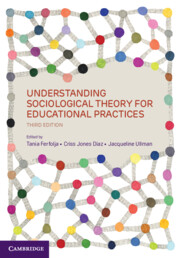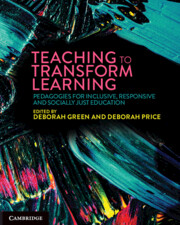2294 results
Exploring African skills 4.0 required for 4IR industry: a systematic literature review
-
- Journal:
- Data & Policy / Volume 6 / 2024
- Published online by Cambridge University Press:
- 30 August 2024, e36
-
- Article
-
- You have access
- Open access
- HTML
- Export citation
Inequality and education in Australia
-
- Journal:
- The Economic and Labour Relations Review ,
- Published online by Cambridge University Press:
- 27 August 2024, pp. 1-22
-
- Article
-
- You have access
- Open access
- HTML
- Export citation

Understanding Sociological Theory for Educational Practices
- Coming soon
-
- Expected online publication date:
- August 2024
- Print publication:
- 31 August 2024
-
- Textbook
- Export citation
3 - Vicious Cycles of Conflict
- from Part I - Apocalypse No!
-
- Book:
- The Peace Formula
- Print publication:
- 15 August 2024, pp 31-46
-
- Chapter
- Export citation
8 - Plenty Makes Peace
- from Part III - Give Peace a Chance!
-
- Book:
- The Peace Formula
- Print publication:
- 15 August 2024, pp 116-131
-
- Chapter
- Export citation

Teaching to Transform Learning
- Pedagogies for Inclusive, Responsive and Socially Just Education
- Coming soon
-
- Expected online publication date:
- August 2024
- Print publication:
- 31 August 2024
-
- Textbook
- Export citation
6 - Unhappy in the Homeland
- from Part II - Kicking out the Turks
-
- Book:
- Foreign in Two Homelands
- Print publication:
- 31 July 2024, pp 268-304
-
- Chapter
-
- You have access
- Open access
- HTML
- Export citation
Triangulating the Relationship Between Education and Attitudes Toward Immigration
-
- Journal:
- Journal of Experimental Political Science , First View
- Published online by Cambridge University Press:
- 31 July 2024, pp. 1-16
-
- Article
-
- You have access
- Open access
- HTML
- Export citation
3 - The Toronto Context
-
- Book:
- Heritage Languages
- Print publication:
- 27 June 2024, pp 29-36
-
- Chapter
- Export citation
4 - The War of Position
-
- Book:
- World of the Right
- Print publication:
- 27 June 2024, pp 108-143
-
- Chapter
- Export citation
3 - Losing the Middle Ground
- from Part I - Voter Flows and Electoral Potentials
-
-
- Book:
- Beyond Social Democracy
- Print publication:
- 27 June 2024, pp 102-119
-
- Chapter
-
- You have access
- Open access
- HTML
- Export citation
9 - Society and Health Inequalities
-
-
- Book:
- The Conservative Effect, 2010–2024
- Print publication:
- 27 June 2024, pp 284-325
-
- Chapter
- Export citation
6 - Education
-
-
- Book:
- The Conservative Effect, 2010–2024
- Print publication:
- 27 June 2024, pp 157-204
-
- Chapter
- Export citation
Chapter 7 - Using digital technologies to learn with our bodies
-
- Book:
- Supporting Innovative Pedagogies with Digital Technologies
- Print publication:
- 13 June 2024, pp 119-133
-
- Chapter
- Export citation
Chapter 5 - Using digital technologies to learn information knowledge
-
- Book:
- Supporting Innovative Pedagogies with Digital Technologies
- Print publication:
- 13 June 2024, pp 76-97
-
- Chapter
- Export citation
Chapter 2 - The nature of learning and teaching
-
- Book:
- Supporting Innovative Pedagogies with Digital Technologies
- Print publication:
- 13 June 2024, pp 20-33
-
- Chapter
- Export citation
Chapter 12 - Your role as a learner and innovator
-
- Book:
- Supporting Innovative Pedagogies with Digital Technologies
- Print publication:
- 13 June 2024, pp 211-234
-
- Chapter
- Export citation
Chapter 6 - Using digital technologies to learn mental procedures
-
- Book:
- Supporting Innovative Pedagogies with Digital Technologies
- Print publication:
- 13 June 2024, pp 98-118
-
- Chapter
- Export citation
Chapter 8 - Collecting and assessing evidence of learning
-
- Book:
- Supporting Innovative Pedagogies with Digital Technologies
- Print publication:
- 13 June 2024, pp 134-156
-
- Chapter
- Export citation
Chapter 10 - Explore interests via co- and extracurricular activities
-
- Book:
- Supporting Innovative Pedagogies with Digital Technologies
- Print publication:
- 13 June 2024, pp 177-190
-
- Chapter
- Export citation



